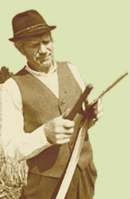Wild and urban trees suffering from the weather extremes
Märt Hanso and Rein Drenkhan look for relations between climate and plant diseases: extremely colder or warmer seasons, as well as longer or shorter seasons might bring along outbreaks of dendrofloral diseases. The authors describe the drought summer and autumn of 2002 and its impacts on our dendroflora. In the following years, many surprising and rare or even new outbursts of tree diseases happened. They compare the impacts to the extremely cold years of early 1940ies and the impacts of that period. In summary, since Estonia is located in the center of climatic changes, more changes and damages to our tree flora can be expected in the future.
Getting to know the red triangle, the symbol of slash-and-burn tillage
Pille Tomson shares her experience and impressions from slash-and-burn activities in the Koli National Park in Karelia. This was once a common way of tillage in Estonia, too. The author explains the methods of slash-and-burn agriculture and the impacts of fire on the nature. Interestingly, the burnt fields are a paradise for biodiversity. In the Koli National Park, slash-and-burn activities are an integral part of the park.
Estonian Nature enquires
Peeter Unt writes about a nature education project in cooperation with Latvia.
Jaanus Elts gives an update of the works on the new bird atlas.
In the memory of Gustav Hegi
Toomas Frey recalls the German botanist Gustav Hegi, a world-famous scientist who passed away 75 years ago. His main publication, the Hegis Illustrated Flora of Central Europe, is still used by botanists.
Tree of the Year: food and medicine from ash tree
Urmas Kokassaar takes a look at ash tree from the cooks and doctors point of view. Its worth mentioning that the seeds of ash tree are supposed to foster ones love life. The fruits of the ash tree have been used to flavour salads and meat dishes. However, the main use of ash tree has been in medicine: the tea from dried ash leaves were added to the expensive black tea, but the ash tea itself had a laxative effect.
Uhaku, the undiscovered pride of North-East Estonia
Taavi Pae insists on visiting one of our biggest karst areas: spring is the best time for that. There are two main falls, which, however, do not function simultaneously. The existence of the falls depends largely on the water regime of the Erra River. In addition to the falls, there are also small cave systems in the Uhaku karst area.
Niidu landscape protection area in the town of Pärnu
Murel Merivee describes a forest protection area at the edge of our summer capital. Its a good place to learn about old-growth forest and get acquainted with at least 65 bird species. The rather small-size protected area encompasses several different habitats, ranging from riverine habitats of the Pärnu River to old-growth forest key habitats. As any other urban protected area, the Niidu protected area is first and foremost threatened by real estate development.
European rarities in Estonia: Boreal Owl a tenant of the Black Woodpecker
Rein Nellis introduces an owl whose numbers decrease in Estonia, just like elsewhere in Europe. Currently there are about 200-400 pairs of Boreal Owls in Estonia, while it once used to be the most numerous owl of our forests. The reasons for such decrease are unknown.
Interview: One of the most representative iconotecs of algae is located in Tartu
Toomas Kukk has interviewed Erich Kukk, a researcher of algae.
Hiking trail: the Poruni primeval valley with all its denudations and primeval nature
Anne-Ly Ferðel invites the readers to the Puhatu Nature Protection Area near the Narva River, to see old-growth forest and the flooded meadows of the Poruni River. There are two trails along the Poruni River: a 2 km-long educational trail and a 10 km-long (forth and back) hiking trail. The denudations are exceptional for North-Estonia, consisting of sandstone. The old-growth forests of Poruni are habitats for the rare flying squirrel, as well as bears and beavers. The article also features the human activities in the area, including the traces of war.
Petrified letters from old times
Oive Tinn describes a small, but extinct feature a graptolite that is hidden in our Dictyonema shale. Graptolites were colonial organisms, consisting of individuals that were connected with each other and they lived in marine conditions. The size of the colony ranged from a few millimeters to about a meter. However, it not very clear how the colonies looked like in real life since their existence was very short in geological time and no close relatives have survived.
Karibu (Welcome!) to the bird-watch hike in the Peace Harbour
Indrek Rohtmets shares his impressions from an early-morning bird-watch to the surroundings of Dar es Salaam, the large capital city of Tanzania. Ornithologists have spotted 470 species in Dar es Salaam, most of them being migratory birds.
Forest giants
Sven Zaèek has observed and photographed the largest mammal of our forests: the elk, a nuisance for forest owners, but a treat for carnivores as well as photographers.
| 

![[IN ENGLISH]](images/gb.gif)






